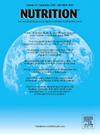Vitamin K2 deficiency and its association with short stature in children: A cross-sectional study
IF 3.2
3区 医学
Q2 NUTRITION & DIETETICS
引用次数: 0
Abstract
Objectives
This study examines the relationship between vitamin K2 (VK2) status and the occurrence of short stature in children.
Methods
A cross-sectional analysis was conducted between January 2021 and August 2022, involving 235 children with a clinical diagnosis of short stature at the Second Affiliated Hospital of Wenzhou Medical University (short stature group) and 454 children with average height (±1 SD) from the same period (healthy group). Serum VK2 levels were compared between the two groups. Multivariate logistic regression analysis was used to identify factors associated with short stature, and spearman correlation analysis was used to examine the relationship between VK2 status and age.
Results
Children in the short stature group exhibited lower VK2 levels (P = 0.019) and a significantly higher prevalence of VK2 deficiency (P = 0.011) compared to the healthy group. VK2 deficiency was identified as an independent risk factor for short stature (OR = 1.535, 95% CI = 1.061–2.222, P = 0.023) through multivariate logistic regression analysis. Furthermore, an inverse correlation was observed between serum VK2 levels and age in children aged 2 to 15 years (ρ = -0.133, P < 0.001).
Conclusions
VK2 deficiency may be associated with an increased risk of short stature in children.
儿童维生素K2缺乏及其与身材矮小的关系:一项横断面研究。
目的:本研究探讨维生素K2 (VK2)水平与儿童身材矮小的关系。方法:对2021年1月至2022年8月在温州医科大学附属第二医院临床诊断为身材矮小的儿童235例(矮小组)和同期平均身高(±1 SD)的儿童454例(健康组)进行横断面分析。比较两组患者血清VK2水平。采用多因素logistic回归分析确定与身材矮小相关的因素,采用spearman相关分析考察VK2状态与年龄的关系。结果:与健康组相比,身材矮小组的儿童VK2水平较低(P = 0.019),而VK2缺乏症的患病率明显较高(P = 0.011)。多因素logistic回归分析确定VK2缺乏是身材矮小的独立危险因素(OR = 1.535, 95% CI = 1.061 ~ 2.222, P = 0.023)。此外,2 ~ 15岁儿童血清VK2水平与年龄呈负相关(ρ = -0.133, P < 0.001)。结论:VK2缺乏可能与儿童身材矮小的风险增加有关。
本文章由计算机程序翻译,如有差异,请以英文原文为准。
求助全文
约1分钟内获得全文
求助全文
来源期刊

Nutrition
医学-营养学
CiteScore
7.80
自引率
2.30%
发文量
300
审稿时长
60 days
期刊介绍:
Nutrition has an open access mirror journal Nutrition: X, sharing the same aims and scope, editorial team, submission system and rigorous peer review.
Founded by Michael M. Meguid in the early 1980''s, Nutrition presents advances in nutrition research and science, informs its readers on new and advancing technologies and data in clinical nutrition practice, encourages the application of outcomes research and meta-analyses to problems in patient-related nutrition; and seeks to help clarify and set the research, policy and practice agenda for nutrition science to enhance human well-being in the years ahead.
 求助内容:
求助内容: 应助结果提醒方式:
应助结果提醒方式:


